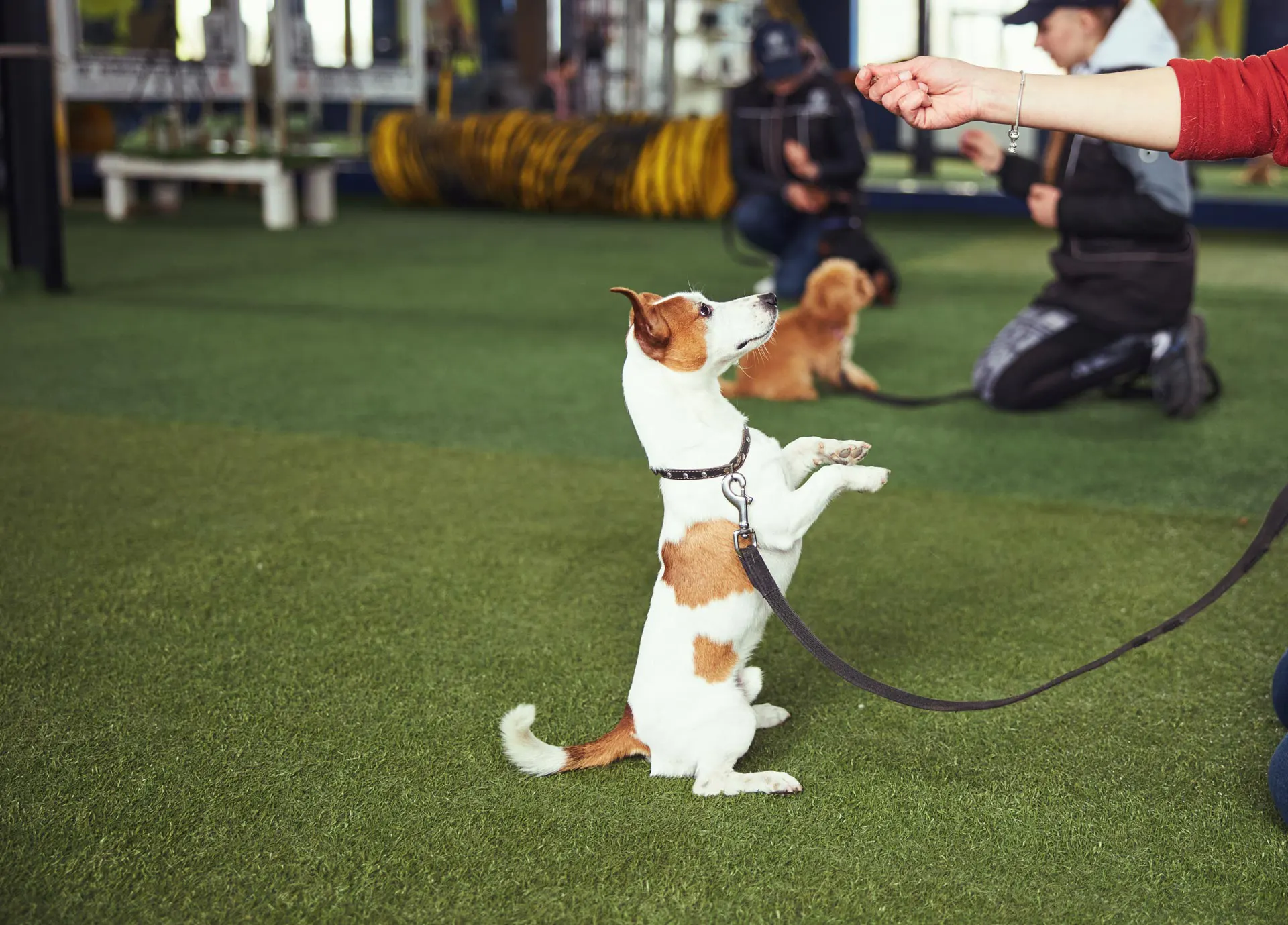In the world of dog training, finding the right path can be a formidable challenge. Consider the journey of our dear friend, Sarah, and her lively Labrador, Bella, which epitomizes this struggle.
Sarah initially enrolled Bella in group classes with high hopes, mirroring the success stories she’d heard. However, the reality was starkly different. Bella struggled in the group class setting. Her anxiety flared up, and her behavior regressed in the presence of other dogs and unfamiliar people. Multiple failed training attempts left Sarah feeling defeated, as she believed Bella was “untrainable.”
But fate had an unexpected turn in store. A chance meeting with another dog owner at a social event sparked a heartfelt conversation. Sharing eerily similar experiences, this encounter convinced Sarah to consider private in home dog training, despite her busy schedule.
As the days turned into weeks, the transformation in Bella’s behavior was nothing short of astonishing. Sarah’s leap of faith in In-Home training proved to be the game-changer. Bella gained confidence and responsiveness, and Sarah learned a valuable lesson – the pivotal role of choosing the right dog training format.
So, if you’re a dog owner in search of the ultimate training experience, picking the right dog training format is a big deal. Just like Sarah discovered, it can make all the difference in unleashing your dog’s full potential. So, let’s dive into the world of dog training and check out your options: Board and Train, In-Home, and Classes, which includes private lessons and group classes.
Understanding and Evaluating Dog Training Formats
Let’s kick things off by getting to know the most common dog training fomarts. We will delve into what each dog training format looks like and its pros and cons.
Board and Train: Doggy Boot Camp
Board and Train programs, often referred to as a “send-away dog training” or “boot camp dog training,” is like sending your furry friend to a doggy college. It offers a comprehensive and immersive approach to dog training. In this format, your furry friend lives with a professional dog trainer for a specified period, which can range from a couple of weeks to several months, depending on your dog’s needs and your training goals. Lets look at board and train pros and cons.
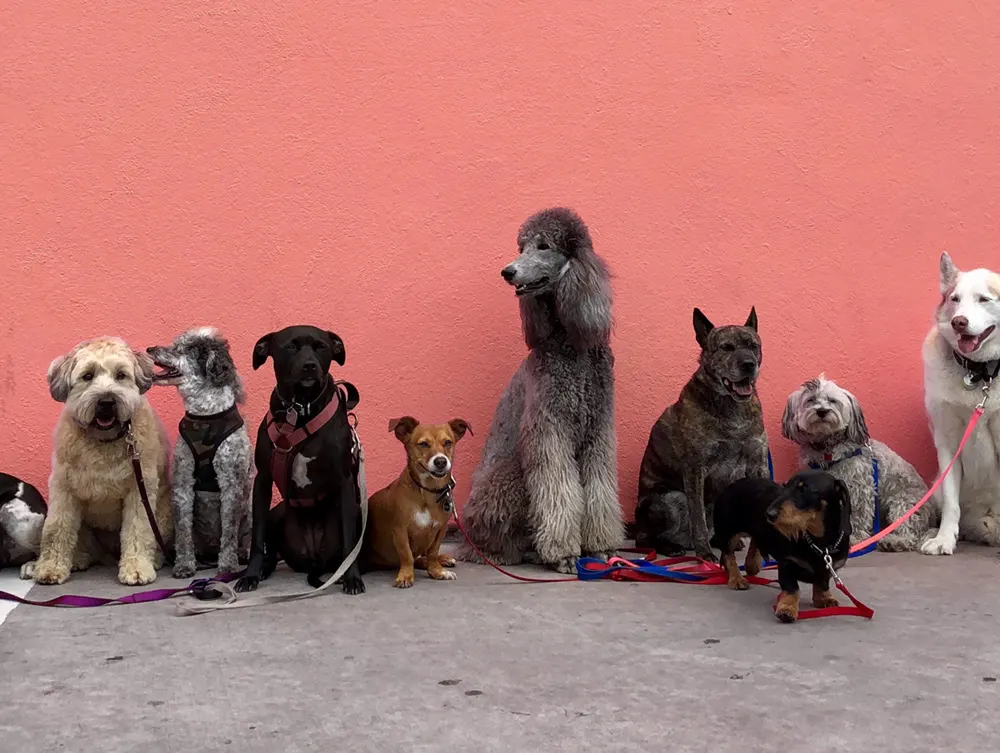
Advantages of Board and Train
- Professional Know-How: First off, your dog will be in the hands of experts. These trainers know dogs like the back of their hand. They’re like doggy whisperers, so you can trust your dog is in good hands.
- Intensive Learning: Your dog will get full-on, concentrated training. Think of it as a doggy boot camp. The more focused sessions mean quicker results.
- Consistency is Key: The training is super consistent. Your pooch gets the same training techniques day in and day out, which helps them understand the rules better.
- Tailored Training: The best part? You can customize the training. Whether your dog needs basic obedience or has some tricky behavioral issues, Board and Train programs can be tweaked to fit your needs.
- Socialization: Your dog might get to hang out with other dogs, making them more sociable. It’s like doggy daycare but with a purpose!
- Convenience: If you’re a busy bee, this is a handy choice. You don’t need to be the primary trainer, so you can carry on with your daily routine.
Disadvantages of Board and Train
- Separation Anxiety Warning: Sending you dog away for training causes them to feel a bit anxious during their stay at the training school, which would slow down their training.
- Cost Concerns: Board and Train programs can be on the pricey side, with a 2 weeks board and train cost averaging around $1000 to $2000.
- Transition Phase: Your dog may get used to the trainer and environment, which can create a brief disconnect when they come back home. Thus, there might be a need for a teaching transfer to make sure your dog listens to you as well as they did to the trainer.
- Set Duration: Board and Train programs have a specific timeframe, so ongoing issues might need more time.
- Quality Matters: The effectiveness of these programs depends almost entirely on the trainer. Picking the right one is crucial.
In-Home Training: Home Sweet Home Training
In-Home training flips the script. Here, the trainer comes to your home, allowing them to work their magic in your dog’s natural habitat. No need to pack up and go to a training center or school; the training happens right where your dog lives.
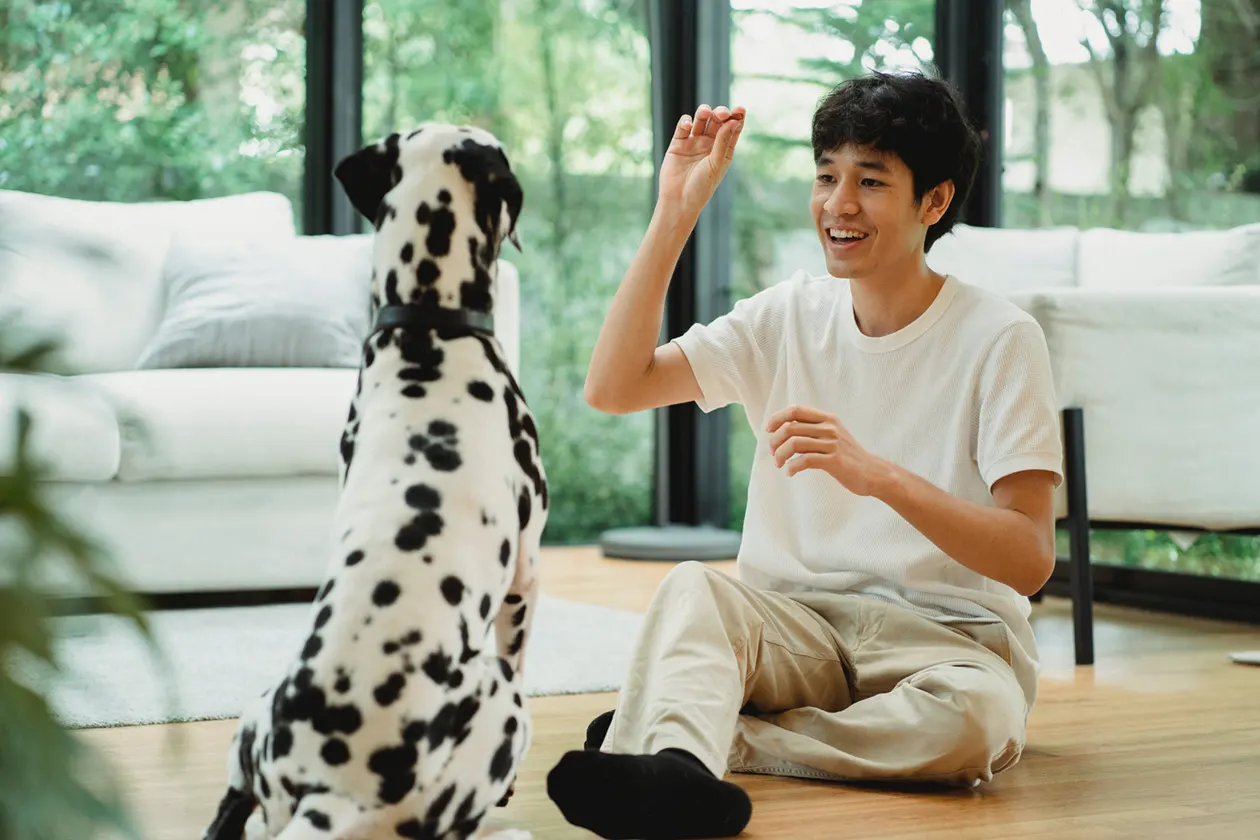
Advantages of In-Home training
- One-on-One Attention: Your dog becomes the star pooch, soaking up all the trainer’s undivided attention.
- Familiar Territory: One of the coolest things about investing in a dog training program at home is that it takes place in your dog’s natural environment. They feel comfortable and secure, which can lead to more effective training.
- Personalized Learning: In-home training is like getting a private tutor. Your dog gets one-on-one attention, and the trainer can tailor the training to your dog’s specific needs and your goals.
- Family Involvement: You, your family, and even other pets can get involved in the training process. This creates a strong bond and ensures everyone is on the same page.
- Real-Life Application: In-home training focuses on the real-world situations you and your dog encounter daily. This means your dog learns how to behave at home, during walks, and even when visitors come over.
- Less Stress: Some dogs can get a bit anxious in group classes or in a new training center. With in-home training, they’re in their happy place, which often leads to less stress and quicker progress.
- Convenient Schedule: You have more flexibility in choosing training times that fit your schedule. No need to rush to a class after work.
- No Commute: Say goodbye to driving to and from a training center. The trainer comes to you, so you save time and gas.
Disadvantages of In-Home training
- Owner Involvement is Key: You’ve got to get your hands dirty and actively participate in the training process.
- Distractions: Your dog’s home environment can be filled with distractions. Squirrels in the yard or the sound of the doorbell can make it a bit challenging to keep their attention on training.
- Less Socialization: In-home training doesn’t provide as much exposure to other dogs as group classes would. So, if socialization is a priority, you might need to arrange play dates.
- Possible Price: In-home training can be a bit pricier than group classes. It’s like the convenience fee you pay for having a trainer come to you.
- Home Habits: If your dog has developed some not-so-great habits at home, the familiar environment might reinforce those behaviors.
Classes: The Doggy Classroom
Training classes for dogs come in two flavors: private lessons and group classes, just like different subjects in school.
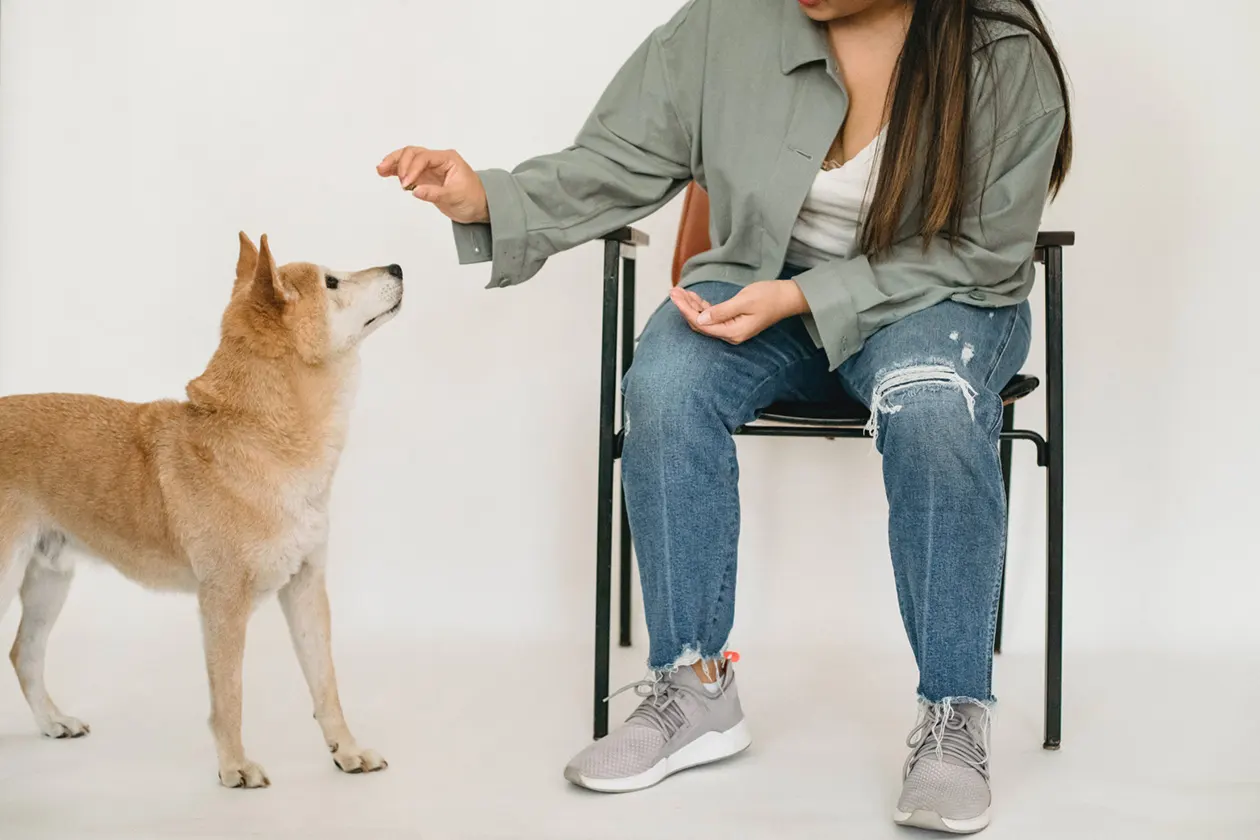
Private Lessons
Private lessons are a bit like hiring your dog their very own tutor. The cool thing is that the trainer tailors the lessons to your dog’s skills and any special quirks they have. It’s like a personalized, one-on-one learning adventure!
Now, you might be wondering, what’s the difference between private lessons and in-home training? The main thing is that, with private lessons, you usually take your dog to a training center instead of having the trainer come to your place. It’s like choosing to go to school instead of having the teacher come to your house.
With private lessons their are two options available to you. You can either stay and actively participate in the training session, or you can choose to drop off your dog for the lesson and then leave.
Advantages of Private Lessons
- Tailored to the Max: The training is personalized to address your dog’s unique needs and the specific concerns you have. It’s like having a private tutor for your furry friend.
- One-on-One Face Time: Your dog gets VIP treatment with undivided attention from the trainer.
- Flexible Scheduling: You have more control over the training schedule. The trainer works around your busy life, making it convenient for you.
- Focus on Specific Goals: Whether its basic obedience or addressing specific issues, private lessons allow you to concentrate on particular training goals.
- Less Distraction: Training in a controlled environment, like a training center, can reduce distractions compared to in-home training.
Disadvantages of Private Lessons
- Investment Alert: Private lessons might pinch your wallet a bit more than group classes, as you are paying for personalized attention.
- Travel Time: You might need to travel to a training center, which can be less convenient than in-home training.
- Limited Socialization: Your dog may not get as much exposure to other dogs, which is essential for their social skills.
- Less Real-World Training: The training center might not replicate the real-life situations your dog faces at home.
- Home Habits: If your dog has developed undesirable behaviors at home, they might not be addressed in the training center.
Group Classes
So, you’ve heard about group dog training classes, but what exactly are they? Well, it’s a bit like taking your dog to school, but with furry classmates. In group classes, a professional dog trainer guides a bunch of dogs and their owners through training sessions together.
Advantages of Group Classes
- Budget-Friendly: Group classes are often more budget-friendly than private lessons. You get expert guidance without breaking the bank.
- Structured Learning: Your dog follows a curriculum that covers all the basics, ensuring a comprehensive training experience.
- Socialization Galore: One of the big advantages is that your dog gets to mingle with other dogs. This helps improve their social skills and makes them more comfortable around other dogs.
- Real-Life Situations: Group classes mimic real-life scenarios, like meeting people and dogs during walks. Your dog learns to behave in various situations.
- Consistency: Since the same trainer works with a group of dogs, you get consistent training methods and advice.
- Supportive Community: You get to connect with other dog owners facing similar challenges. It’s like a support group for pet parents
Disadvantages of Group Classes
- Limited Personalization: In group classes, training is more generalized. It might not address your dog’s unique quirks or specific issues.
- Distractions: With other dogs and people around, your pooch might get distracted during training.
- Fixed Schedule: You have to stick to the class schedule, which might not always align with your availability.
- Limited Attention: The trainer’s attention is divided among all the dogs in the class, so you might get less individualized guidance.
- Not Ideal for All Dogs: Some dogs, especially those with behavioral problems, might not thrive in a group setting.
Assessing Your Dog’s Needs and Goals
Now that you’re familiar with the training formats, let’s talk about how to match the right one to your dog’s unique needs.
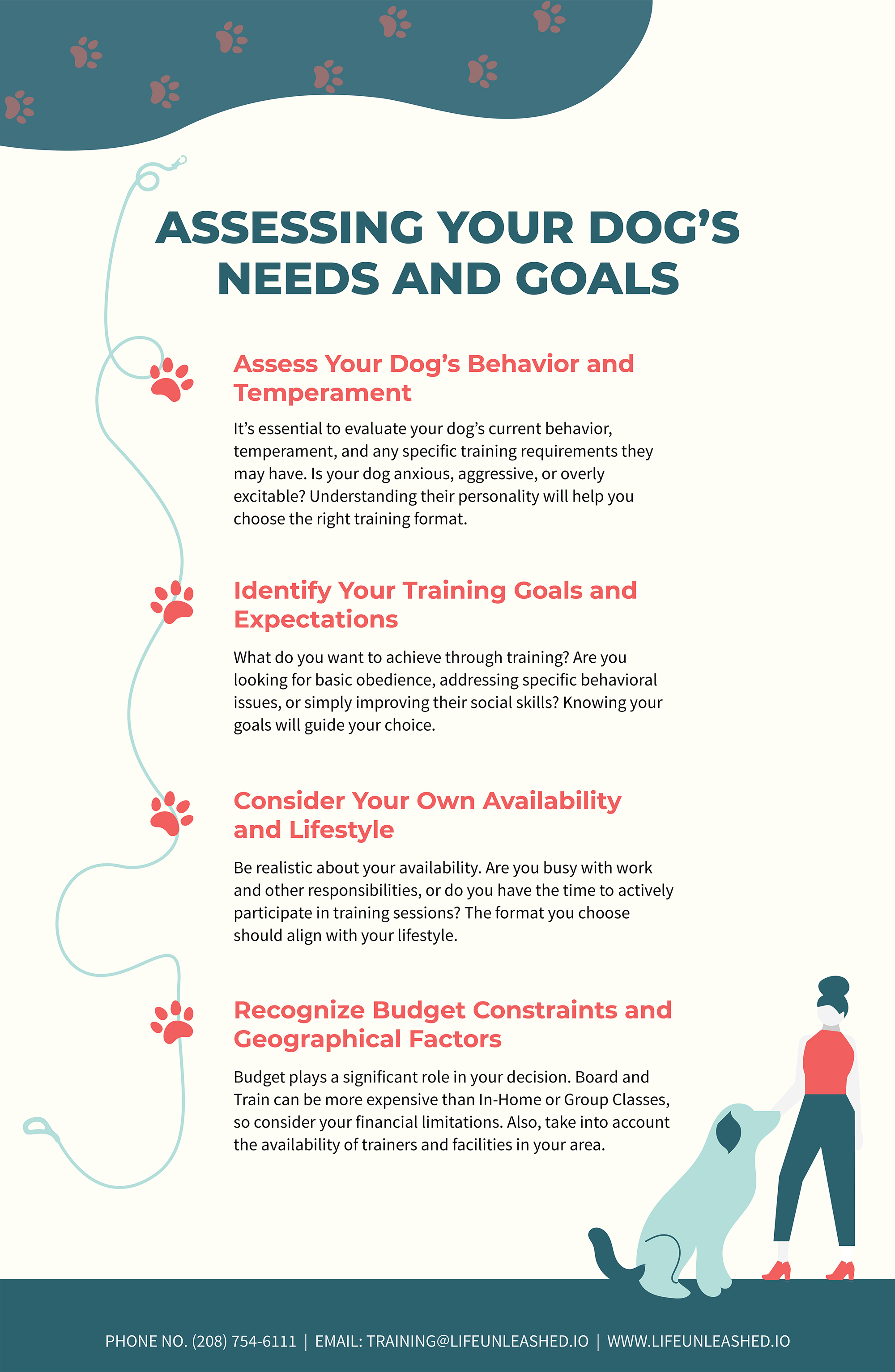
A. Assessing Your Dog’s Behavior and Temperament: It’s essential to evaluate your dog’s current behavior, temperament, and any specific training requirements they may have. Is your dog anxious, aggressive, or overly excitable? Understanding their personality will help you choose the right training format.
B. Identifying Your Training Goals and Expectations: What do you want to achieve through training? Are you looking for basic obedience, addressing specific behavioral issues, or simply improving their social skills? Knowing your goals will guide your choice.
C. Considering Your Own Availability and Lifestyle: Be realistic about your availability. Are you busy with work and other responsibilities, or do you have the time to actively participate in training sessions? The format you choose should align with your lifestyle.
D. Recognizing Budget Constraints and Geographical Factors: Budget plays a significant role in your decision. Board and Train can be more expensive than In-Home or Group Classes, so consider your financial limitations. Also, take into account the availability of trainers and facilities in your area.
Dog Training Cost Calculator:
We’ve whipped up a simple cost calculator to give you an estimate of potential dog training prices. Remember, These are cost estimates. Your costs might be higher or lower based on your choices and location. It’s crucial to research local trainers, read reviews, and get personalized quotes to make an informed decision.
Check out our Ultimate Guide to Calculating Dog Training Cost.
Dog Trainer’s Advice: It’s important to communicate openly with your chosen trainer about your dog’s needs, your goals, and your availability. A good trainer will help you make the right decision for your specific situation.
How to Match the Right Training Format to Your Dog
With these considerations in mind, let’s break down how to match the right training format to your furry friend.
A. Tailoring the Training Format to Your Dog’s Unique Needs: Each dog is different, so consider what will work best for your pooch. If your dog is particularly anxious, In-Home training might be more suitable. For an energetic and social dog, Group Classes can provide the right environment.
B. Common Scenarios and the Best Format for Them: Let’s explore some common scenarios:
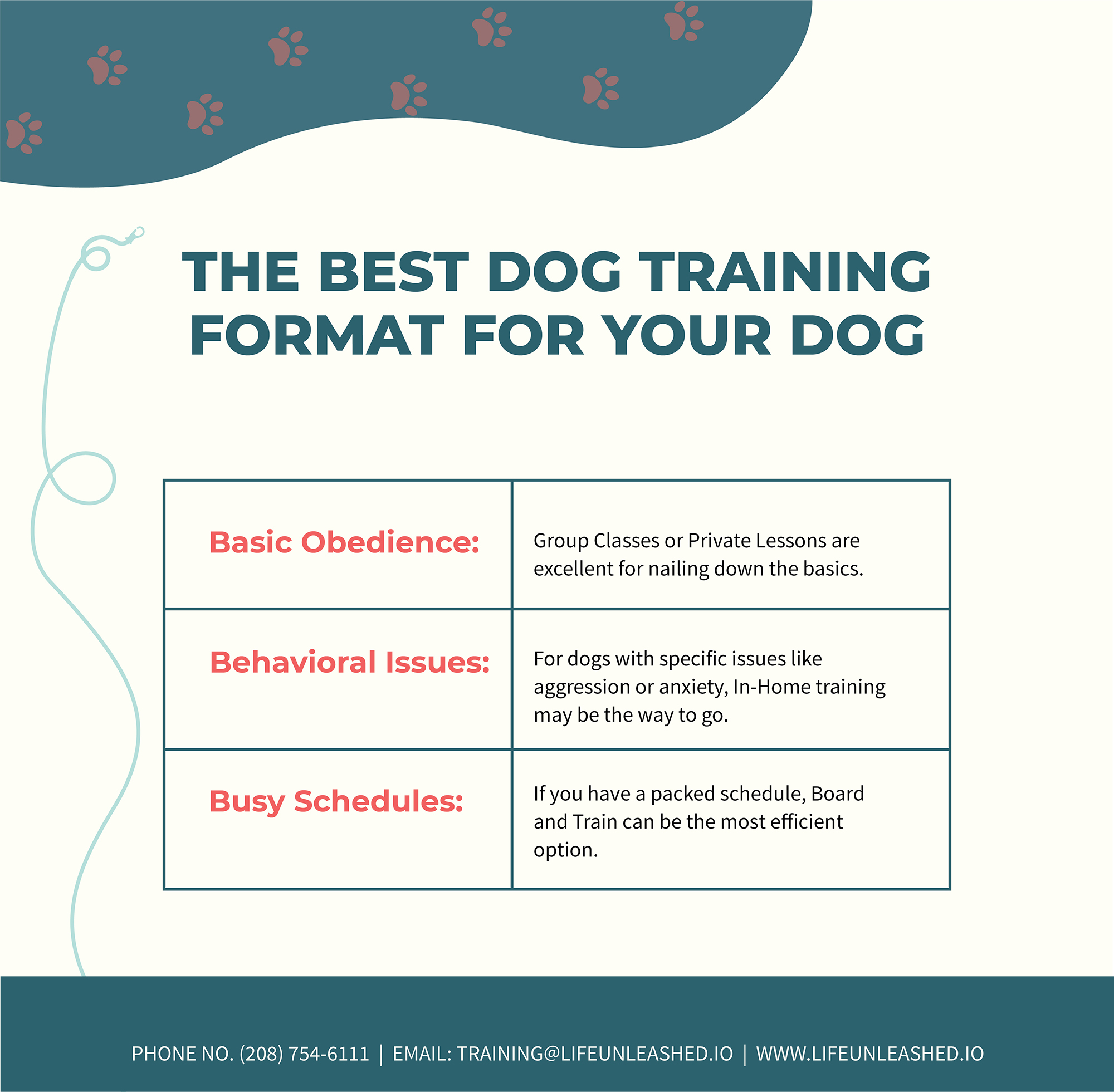
- Basic Obedience: Group Classes or Private Lessons are excellent for nailing down the basics.
- Behavioral Issues: For dogs with specific issues like aggression or anxiety, In-Home training may be the way to go.
- Busy Schedules: If you have a packed schedule, Board and Train can be the most efficient option.
C. Combining Formats for a Comprehensive Approach: Sometimes, a mix of formats can be the most effective. Like our dear friend Sarah, you might start with In-Home training to address specific issues and then transition to Group Classes for socialization and advanced training.
A holistic approach can often yield the best results. Our featured trainers recommend combining In-Home training with Group Classes to cover all the bases. Sometimes the dog trainer will even do a hybrid schedule. This is what Wolfman’s Canines does. They have a hybrid plan where it is a 2 week board and train plus 6 one-on-one sessions.
Conclusion
In the world of dog training, there’s no one-size-fits-all solution, much like your dog’s personality! If there is one thing we can learn from Sarah’s example is that our dogs are all unique and we might have to combine different dog training methods to unleash the best traits of our furry friends. The best dog training format depends on various factors, and it’s crucial to evaluate your dog’s needs and your lifestyle.
With the right dog training format and a professional trainer by your side, you and your dog can embark on a journey of learning and bonding that will result in a happier, better-behaved furry companion.
That is why we at Unleashed have created a dog trainer hub where you can find the right dog trainer for you and your special dog. So, take your time, do your research, and find the perfect fit. Your dog will thank you with a wagging tail and a lot of love! Happy training!
Connect with a trainer today and start your journey to freedom and fulfillment for your family!
Still need help finding the right trainer for your dog?
We have an entire database of vetted dog trainers right here at Unleashed. Check out our featured trainers and pick from a variety of in-home, board and train, and group class style trainers that your needs, location, and budget.
FAQs About Dog Training Fromats
Where Is The Best Place To Train My Dog?
When selecting a dog training method, consider your dog’s unique traits:In-Home Training: Great for anxious dogs, offering a familiar and less stressful environment.Group Classes: Ideal for energetic and social dogs, providing structured social interaction and mental stimulation.
What is in-home dog training?
In-home dog training means the trainer comes to your home, allowing them to work their magic in your dog’s natural habitat. No need to pack up and go to a training center or school; the training happens right where your dog lives.
What are the benefits of in home dog training?
- Your dog gets their trainers undivided attention
- Your dog feels comfortable and secure, leading to more effective training.
The dog trainer personalize learning to your dog’s specific needs and your goals. - Your family gets involved in the training process.
- In-home training focuses on the real-world situations you and your dog encounter daily.
- Reduced stress some dogs can get a bit anxious in group classes or in a new training center.
- You have a more flexible schedule because you choose training times that fit your schedule.
What to watch out for when my dog is undergoing training?
- Stress and Anxiety: Be attentive to signs of stress or anxiety in your dog, such as excessive panting, trembling, or avoidance behavior.
- Negative Reactions: Watch for negative reactions to training methods. Reconsider taring approach if your dog becomes fearful, aggressive, or excessively submissive.
- Lack of Progress: If your dog consistently struggles with a particular command or behavior, it may be time to adjust your training methods.
- Inconsistency: Ensure that you and everyone(including family members) involved in the training are consistent with commands and rewards to prevent confusion for your dog.
- Health and Well-being: Prioritize your dog’s health and well-being. Training should never compromise their physical or emotional welfare.
- Feedback: Be open to feedback from a professional trainer or behaviorist, as they can provide valuable insights and guidance.
How long does it take to see results in dog training?
The timeline for seeing results in dog training can vary. Typically, basic obedience commands can be learned within 3 to 6 weeks of consistent training. More complex behaviors might take several months to master. However, it’s crucial to understand that every dog is unique, and various factors, including the dog’s age, breed, and prior training, can impact the learning process. Dog training is an ongoing journey, and ongoing reinforcement and practice are necessary to maintain and reinforce learned behaviors.



